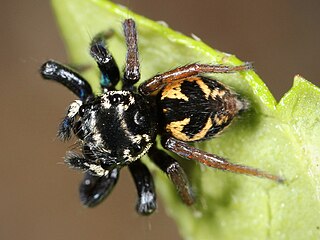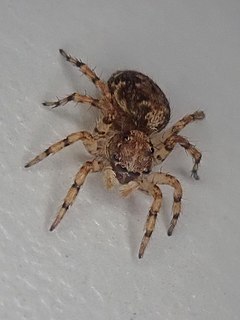
The recluse spiders, also known as brown spiders, fiddle-backs, violin spiders, and reapers, is a genus of spiders that was first described by R. T. Lowe in 1832. They are venomous spiders known for their bite, which sometimes produces a characteristic set of symptoms known as loxoscelism.
Aillutticus is a genus of South American jumping spiders that was first described by María Elena Galiano in 1987.
Amphidraus is a genus of South American jumping spiders first described by Eugène Simon in 1900. It was previously considered a synonym of Nebridia, but this was later rejected by Jerzy Prószyński, who claimed that merging the two genera wasn't supported by previous diagnostic drawings.

Breda is a genus of jumping spiders that was first described by George Peckham & Elizabeth Peckham in 1894.

Corythalia is a genus of jumping spiders that was first described by Carl Ludwig Koch in 1850.
Helvetia is a Neotropical genus of the spider family Salticidae. The genus name is derived from Helvetia.

Hyetussa is a genus of the spider family Salticidae.

Marma is a genus of South American jumping spiders that was first described by Eugène Louis Simon in 1902.

Pachomius is a genus of jumping spiders that was first described by George and Elizabeth Peckham in 1896. Uspachia was merged into genus Romitia in 2007, and all nine species were merged into Pachomius in 2015. The name is derived from Pachomius, the founder of cenobitic monasticism.

Peckhamia is a genus of jumping spiders that was first described by Eugène Louis Simon in 1900. It is named in honor of George and Elizabeth Peckham, and is considered a senior synonym of the genus Consingis.

Nops is a genus of medium-sized South American, Central American, and Caribbean spiders in the family Caponiidae, first described by Alexander Macleay in 1839. It has a great richness on the Caribbean islands, and most mainland species are located in high proportion toward the Caribbean coast. It likely has a neotropical distribution, though most species of South America are known only from the coast of Colombia and Venezuela, including the islands of Aruba, Curaçao, Bonaire and Trinidad.

Anapistula is a genus of dwarf orb-weavers that was first described by Carl Eduard Adolph Gerstaecker in 1941.

Mastophora, also known as bolas spiders, is a genus of orb-weaver spiders first described by E. L. Holmberg in 1876. They can be identified by a pair of lumps on the dorsal surface of the opisthosoma, though not all males will have these lumps.
Metagonia is a genus of cellar spiders that was first described by Eugène Louis Simon in 1893.

Thymoites is a genus of comb-footed spiders that was first described by Eugen von Keyserling in 1884.

The Sitticini are a tribe of spiders in the family Salticidae. The tribe has been divided into two subtribes, Aillutticina, with five Neotropical genera, and Sitticina, with five genera from Eurasia and the Americas. One genus is unplaced within the tribe. The taxonomy of the tribe has been subject to considerable uncertainty. It was clarified in 2020.
Cinetomorpha is a genus of goblin spiders first described by Eugène Louis Simon in 1892. It is a senior synonym of Lucetia, and Yumates.












